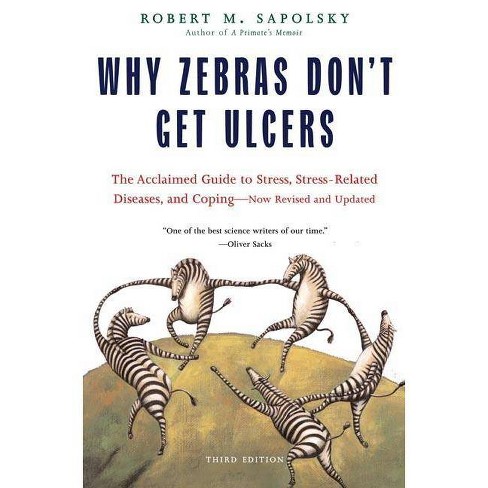We each have different ways of managing the stress in our lives. Make no mistake, we all have some stress to deal with. Most of us have been through times when the stress in our lives felt overwhelming. For many of us, these times are few and far between. But for some people, stress can feel overwhelming on a chronic basis.

Why Zebras Don’t Get Ulcers, by Robert Sapolsky, Ph.D., explains in significant detail the similarities and differences between the human stress response and animal stress responses. One strength of this book, in comparison to other mass market books about science and health, is the emphasis on experimental science that has shaped our understanding of stress over the years. The author gives the reader credit for being able to understand the complex physiology of stress and does not “dumb down” the material. If you are looking for “Chicken Soup for the Stressed,” this book is not for you. There are no recommendations here for which type of scented candles will be the most relaxing during your bath; but there are descriptions of many of the important and groundbreaking experiments that form the basis for current knowledge about stress.
Some of these experiments fall under the topic of stress and illness. The links between stress, pain, the immune response, and various illnesses are covered, as are the effects of aging on our ability to handle stress. The relationship between stress and depression is also addressed, in particular the role of “learned helplessness.” Learned helplessness is a concept established in animal experiments. The basic idea is that when we learn that we cannot control our environments to prevent negative experiences, we experience surprisingly negative consequences. We have trouble coping with situations that may have otherwise seemed quite manageable. We may assume that we cannot control other, unrelated, negative events that in reality are quite preventable. One of the reasons this concept has received the attention it has is because it is a testable theory. Unlike, for example, a theory that depression is often caused by an unresolved Oedipal complex, learned helplessness has been demonstrated in well-crafted experiments, some of which are described in the book.
If someone has “learned” that small stressors are unmanageable, it doesn’t take a rocket scientist to see how that person may experience greater day-to-day stress. Cognitive therapy can help us “unlearn” some of these lessons. As adults, this learning takes the form of beliefs. These beliefs can be about ourselves, life, the world, or other people. Typically we do not stop to ask ourselves how accurate these beliefs really are. While we might be quite likely to stop and assess the validity of our other beliefs about religion (e.g., “God created mankind”) or politics (e.g., “changing term limits for our mayors is a bad idea”), we seldom do the same for beliefs about our ability to positively influence our lives (e.g., “others don’t find me likable”). Certain beliefs we have about our lives can have important effects on our stress levels, as Sapolsky explains.
Sapolsky explains about the importance of predictability and a sense of control as factors that impact how much stress we experience. An example can be seen in the contrast between two workers: one who averages 60-hour work weeks because she feels a sense of responsibility to get her sizable amount of work done; and another who averages 60-hour work weeks because her boss randomly demands that she stay late and work weekends. It is likely that the former woman will feel less stress because she feels a greater sense of control over the demands put on her, and sees her work schedule as more predictable. Sapolsky presents us with the scientific basis for these principles, explaining the animal experiments that demonstrate these ideas, and providing the human side as well.
The writer explained in an interview how his writing style was partially influenced by an experience during his graduate training, when he lectured on science to textile design students with little science background. During these lectures he describes feeling “an enormous pressure to be clear, and to have a good sense as to when people are about to go berserk with too many terms,” and “when you have to stop and give an anecdote or metaphor.” This sensitivity to the background and interests of the lay reader comes through in “Why Zebras Don’t Get Ulcers,” which is written in an engaging style that is typically easy to follow. While there are points in the book where some readers may feel overwhelmed with details about the secretion of glucocorticoids, by and large this book makes a very complex topic remarkably digestible for the average reader.
